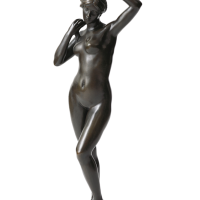14. BERTRAM MACKENNAL

Bertram Mackennal, arguably one of Australias most successful artists of the late nineteenth/early twentieth centuries, found great success living and working in Britain and Europe. At the time, his success outshone his Australian creative contemporaries such as Tom Roberts (1856-1931) and Arthur Streeton (1867-1943) in their quest for international recognition however his profile is less well known to Australians today. Painting, as a medium, has historically been favoured over sculpture by collective Australian tastes and as a result, the enormous talent and output of early sculptors such has Mackennal have been under-appreciated due to the popularity of other artistic media.
A retrospective exhibition of Mackennals work at the Art Gallery of New South Wales in 2007 reacquainted contemporary Australia with Mackennals three-dimensional forms which, during his lifetime, represented the most advanced examples of sculptural production. One of this nations most important early sculptors, he was responsible for influencing the development of the medium of sculpture in this country. This exhibition showcased the enormous ability of Mackennal not only as an artist but also as a draftsman and technician. The present work, Morning (Woman Washing her Hair) c1902 featured in this retrospective and is an important example of the ascendant feminine, 1 that is, the Symbolist representation of the changing role of women in society. Through this non-commissioned work, Mackennal was able to convey the spirit of this fascinating period of Edwardian history which saw the attitudes of women towards their own role in society changing at a rapid pace.
Here, the French critic Jules Christophe in 1888 describes Symbolism as an artistic style: Symbolism was born out of disgust with all that was vulgar, all that made use of external and outmoded Naturalist formulae; symbolism, the seeker of souls, of delicate subtleties of meaning, of emotional states, of fugitive, frequently sorrowful and significant images; an art therefore which is esoteric.2 Mackennal used Biblical stories or Greco-Roman legends and myths as a source for much of his work, and like many of his Symbolist contemporaries, emphasised the role of the female. The female figure in Morning has a classical stance with one foot slightly raised and both arms bent upwards tending to her hair. Despite being most well-known for his large, life sized sculptural works, Mackennals smaller, more domestically suitable, statuettes were collectable and proved a commercial success for the artist. His smaller works tended to better present the sensuous line, elegant balances and meticulous fine details which are present in the current work, Morning.
It lacks the psychologically loaded insignia which are present in the Sarah Bernhardt bronze relief (c1892-93) and Mackennals magnus opus of the same date, Circe. Circe, the Greek goddess, was depicted by Mackennal with outstretched arms casting a spell and emphasises the destructive, dangerous power of the female. A life-size plaster cast of Circe was exhibited at the Royal Academy summer exhibition in 1894 however was considered too indecorous - the base, which featured a band of fornicating figures, was covered for the duration of the exhibtion. Circes failure to find a buyer caused Mackennal to tone down the overt sexuality which proved challenging to the late Victorian public. Morning, which dates c1902, is characteristic of the more subtle attributes which were employed by Mackennal marking his transition into the British New Sculpture movement.
Footnotes:
1. Noel Hutchinson, in Edwards, D., Bertram Mackennal, Art Gallery of New South Wales, , Sydney, 2007, p.109
2. Jules Christophe quoted in Christian, J. (ed.), The Last Romantics: the romantic tradition in British art: Burne-Jones to Stanley Spencer, Barbican Art Gallery/Lund Humphries, London, 1989, p.3
Caroline Jones MA (Art Admin.)